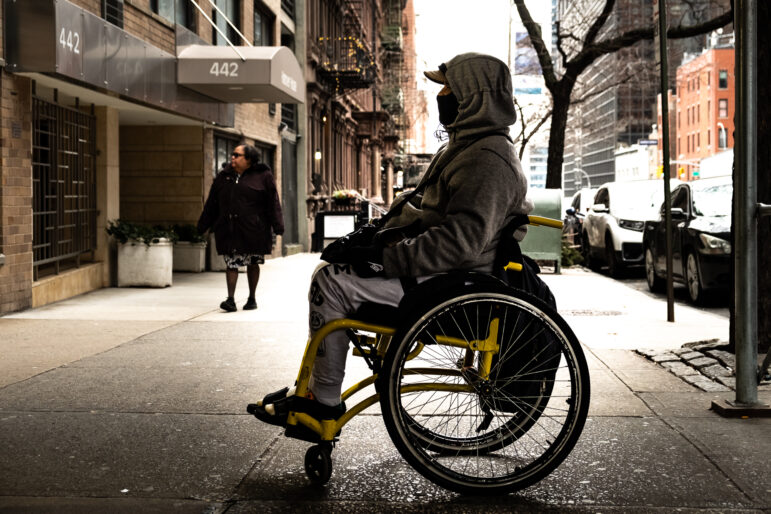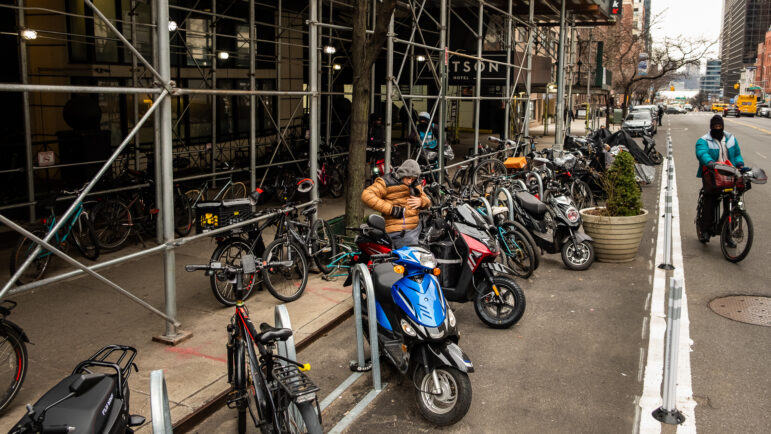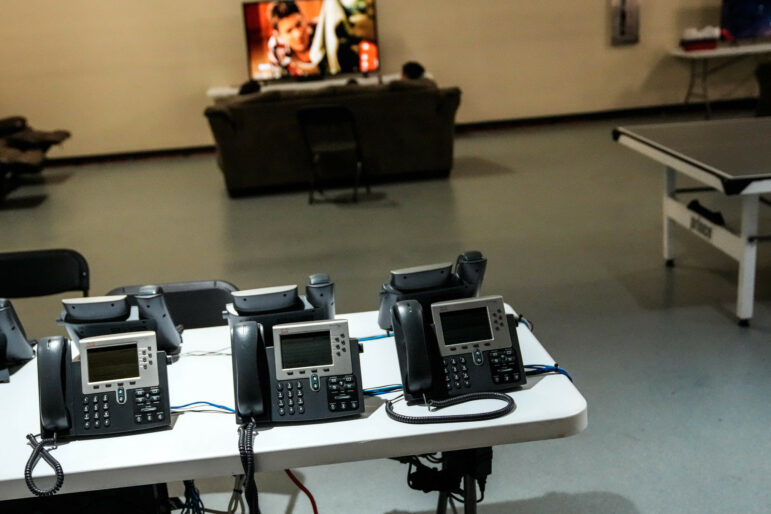For weeks, City Limits has been speaking to people sheltered at two of the city’s Humanitarian Emergency Response and Relief Centers, or HERRCs: one at The ROW Hotel and another at The Watson Hotel in Manhattan, where adult men were recently transferred out and relocated to a congregate facility at the Brooklyn Cruise Terminal in Red Hook.

Adi Talwar
An asylum seeker outside the Watson Hotel in Manhattan, which the city has been using as a Humanitarian Emergency Response and Relief Centers to shelter migrants. Adult men were transferred out of the shelter this weekend to make way for migrant families and children.Lea la versión en español aquí.
New York City recently opened a fifth Humanitarian Emergency Response and Relief Center (HERRC) as a temporary shelter at the Brooklyn Cruise Terminal, reminiscent of the two now-abandoned centers that had been planned for Orchard Beach and briefly operated on Randall’s Island.
The Red Hook site is the city’s latest shelter space for asylum seekers, more than 40,000 of whom have arrived from the southern border since last spring. But the location has been condemned not only by homeless advocacy groups—such as Legal Aid and the Coalition for the Homeless—and immigrant rights advocates, but also by some shelter residents themselves who this weekend resisted the city’s effort to move them from a hotel in midtown to the new waterfront facility.
The city plans to convert the Watson Hotel into a HERRC for migrant families and children. The building had previously been housing hundreds of single adult male migrants and asylum seekers, many of them with jobs as food delivery workers. City Limits last week spoke to more than a dozen people staying at the Watson in the days before the city’s transfers began, many of whom said they did not want to leave.
One young Colombian man, who asked that his name not be used for fear of retaliation, said he didn’t want to go back to living head-to-toe on thin cots after previously spending weeks in the Randall’s Island HERRC, which the Adams administration shut down this fall just a month after it opened. After the short-lived and heavily criticized tent facility shuttered, the City Council suggested 10 sites as an alternative, and the Watson Hotel was one of them.
“Hotels have always been the better short-term option, in contrast to erecting tents in inaccessible parts of New York City that are prone to flooding,” the Legal Aid Society and the Coalition for the Homeless said in a joint statement during the weekend.
The Colombian man, along with hundreds of others, has since been transferred from The Watson to the Brooklyn Cruise Terminal. There, they received two blankets and a lockbox—about the size of a domestic toolbox—to store valuables. Some transferees said they must entrust their belongings to other residents at the shelter when they head out for the day to work.
“We were told that this was going to be for one month,” said the Colombian man after entering the Brooklyn HERRC. “But we don’t really know.”
Others have raised concerns about oversight of HERRCs more generally. The sites are run by the city’s Office of Emergency Management and the Health + Hospitals Corporation, unlike traditional city shelters overseen by the Department of Homeless Services (DHS), which by law have to meet certain standards required by New York’s unique right to shelter rules. Mayor Adams drew condemnation from homeless and immigrant rights advocates last week for saying he doesn’t believe asylum seekers “fall into the whole right to shelter conversation.”
City Council Immigration Committee Chair Shahana Hanif called conditions at the Brooklyn Cruise Terminal a “failure to meet the basic standards required by the City’s Right to Shelter law,” echoing concerns she and others expressed at a Council oversight hearing on HERRCs in December.
“This administration has created a system of HERRCs which are currently operating as a pseudo shelter system with none of the minimum standards or legal protections in place for shelters,” Hanif said at the time. Administration officials pushed back against that charge.
“This idea that we’re somehow circumventing the shelter system with a shadow system, I think were your words, is nonsense,” OEM Commissioner Zachary Iscol* said during the hearing. “People are open to go to the shelter system if they need to.”
What HERRC residents say
More than 70,000 people slept in a DHS shelter Tuesday night, a number that does not include people in HERRCs. As of Jan. 25, there were over 27,800 asylum seekers in both the city’s shelters and HERRCs, and over 42,400 in total have passed through the system since last spring, according to Health + Hospitals. There were 5,414 people staying in just four HERRCs in mid-December, before the Brooklyn Cruise Terminal site opened, officials said at the time.
For weeks, City Limits has been speaking to people sheltered at two of the HERRC sites: The ROW Hotel and The Watson in Manhattan. At both hotels, those we spoke to cited concerns about the quality of food, as well as tensions between residents and staff.
One resident at the ROW described women being yelled at in front of their young children. Some at The Watson complained about security guards shouting inappropriately in response to questions from migrants, and that a fight broke out between a resident and a guard on one occasion (NYC Health + Hospitals’ press office, however, said it had no record of any such incident at the hotel, adding that 90 percent of the HERRCs staff are bilingual to ensure clear communication between staff and guests).

Adi Talwar
Cycles and scooters parked in front of the Watson Hotel in Midtown Manhattan on Jan. 25. Many asylum seekers have found work as food delivery drivers.
The most common complaint heard at both HERRCs was about the food, which residents described as unpalatable. One young man residing in the Watson Hotel said he got ill after eating a tuna sandwich in the cafeteria. “I called my mom in Venezuela and asked her for advice on how to recover,” he said. One Haitian family living in the ROW said the food gave them a stomach ache. “Fruit came stone-cold, frozen. Vegetables and salads were frozen,” explained the 41-year-old father. They preferred to go out for food on the streets.
A spokesperson for NYC Health + Hospitals spokesperson said the agency regularly receives feedback from guests through staff who listen to requests and complaints.
“Additionally, our staff go door to door to gather feedback, and have completed a guest survey about food. In response, we discontinue meals that get low scores, and prepare meals that get higher scores,” the rep said, saying microwaves have also been installed at all HERRCs.
“We are now ordering sandwiches based on the number of residents who want them,” the spokesperson added, “and have plans in place to donate 100 percent of our unused meals to ensure no food is wasted.”
At the Watson last week, in the days before the city opened the Brooklyn Cruise Terminal site and began transferring single adults out of the hotel, residents there said they’d been given conflicting information about the moves. Some reported that when they asked staff, they were told they could stay at the hotel. Others said the opposite, creating uncertainty.
Last week, NYC Health + Hospitals Spokesperson Adam Shrier said moves to the Brooklyn site would be voluntary. Of the 15 people City Limits spoke to before the moves, none had been informed about the pending transfers directly, but said they found out through posters in the hotel and word of mouth.
“Nobody told me anything,” one young Venezuelan, who did not want to be identified by name, told City Limits in Spanish. “I found out because I read about it on a poster that was posted in the corridors.”
The 23-year-old told a reporter he would not go to a cavernous barrack terminal where he would have no privacy. At the hotel, he shared a room with only one other person, while photos of the Brooklyn Cruise Terminal site show green cots lined up closely to one another. Two residents of Venezuelan origin said goodbye to their shelter acquaintances while City Limits was there, saying they’d preferred to go to Canada than move to another shelter facility.
That same day, others were arriving at the hotel for the first time in search of a bed. After waiting a few minutes outside the entrance, where dozens of bicycles and electric scooters belonging to immigrants who work as delivery drivers were secured to scaffolding, HERRC staff told them they could not stay there, and handed them a piece of paper directing them to the Bellevue Men’s Intake Shelter at 30th Street instead.
Adams has repeatedly called for the federal government to provide additional funds and resources for asylum seekers, estimating at one point that the crisis could cost the city as much as $2 billion. New York Gov. Kathy Hochul pledged in her state budget announcement Wednesday to allocate $1 billion for asylum seekers over the next year, including $767 million to pay 29 percent of city shelter/HERRC costs.

Mayor Eric Adams visits the Brooklyn Cruise Terminal in Red Hook on Monday, January 30, 2023. 
Mayor Eric Adams visits the Brooklyn Cruise Terminal in Red Hook on Monday, January 30, 2023. 
Mayor Eric Adams visits the Brooklyn Cruise Terminal in Red Hook on Monday, January 30, 2023. 
Mayor Eric Adams visits the Brooklyn Cruise Terminal in Red Hook on Monday, January 30, 2023.
Adams has defended the Cruise Terminal location, promising it will be a “heated, well run space.” Photos from a visit he made to the facility Monday show the mayor playing pingpong with residents and touring a cafeteria stocked with fruit.
As of Tuesday afternoon, says the Colombian immigrant staying at the site, he and others had not been provided with extra blankets, as a cold front is expected to chill the city over the weekend.
From one shelter to another
Migrants staying in the city’s traditional DHS shelter system say they’ve also been subject to frequent transfers and at times, poor conditions. Since arriving in New York in July, Colombian native Bonnie Mosquera said her family was assigned to three different shelters before being placed in a two-bedroom apartment on the second floor of a shelter in the Bronx at the end of September.
At first glance the place seemed ideal: her two children, a 10-year-old and a 3-year-old, would have their own bedroom, while Mosquera, 34, and her husband, would share the other.
“The problems started a few days after we moved in September,” said Mosquera in Spanish. The bathroom ceiling was leaking, flooding the bathroom floor, she said. She quickly mopped up and dried the puddle to prevent accidents. Then there was a lack of heat in Mosquera’s room when the cold season started in October, while rats left their little trails of poop at night, she said.“The exterminator came, set me up some rat traps and glue traps, and that was it,” said Mosquera, noting that the rats continued to leave traces in the apartment.
Matters came to a head on Jan. 7, when Mosquera fell in the bathroom and couldn’t move after slipping in the puddle made by the leaky roof. She was taken to Jacobi Hospital.
“Fortunately I have health insurance,” said Mosquera, who is enrolled in NYC Care, a healthcare access program for low-income and noncitizen New Yorkers who do not qualify for or cannot afford other coverage.
Since getting injured, the family income has been reduced. Both adults were in the cleaning sector and Mosquera fears losing her job as she is currently using crutches and unable to stand for long periods of time.
“It is unfortunate that conditions in the shelter system are bad enough that people can sustain any type of injury,” said Murad Awawdeh, executive director of the NY Immigration Coalition (NYIC), one of several advocacy groups urging city and state lawmakers to focus more resources on connecting New Yorkers in shelter with permanent homes, rather than frantically opening emergency sites.
They’ve pressed lawmakers to expand the city’s rental assistance program, CityFHEPS, to include undocumented people, who are currently ineligible for the rental assistance.
When asked about Mosquera’s situation, the city’s Department of Social Services (DSS) said it has taken action to address the problems she described. “Protecting the health and safety of our clients is our top priority,” said Neha Sharma, a spokesperson. “Whenever we learn of any unexpected maintenance issues with a unit, we work to comprehensively address the issue as quickly as possible.”
On Jan. 13, Mosquera and her family were offered a transfer to another shelter in Brooklyn after City Limits inquired about her case. They made the move, though said they had to rely on a mutual aid group to help transfer their belongings to the new location.
“Thank goodness it was me who fell and not my children,” said Mosquera.
*An earlier version of this story incorrectly attributed this quote to another city official, based on an error in the City Council’s transcript of the hearing. The attribution has been corrected.









One thought on “Tensions Over Conditions at Emergency Shelters as NYC Struggles to House Migrants”
City Limits:
We have been hearing that NYC residents currently entering the City’s homeless “shelter” system are being placed in the boroughs as Manhattan is being used for new migrants and Manhattan resources are at capacity.
Could City Limits investigate this?